|
When I showed Drew the bouquet I collected on my morning walk, he said, "Well, it looks like it's seen better days." "True," I conceded, as I turned the brown, crispy, shedding remains of once vibrant wildflowers in my fingers. "But there's a story here." "I thought there might be," he nodded, knowing that the story wasn't far behind. And it wasn't. It all started last Sunday morning when I set forth on a well-trodden path, a ritual of sorts, from our condo in Portland, Maine to Portland Head Light, a 15-minute drive away. The Head Light is the oldest lighthouse in Maine, completed in 1791, along the rugged shore of the shipping channel into Portland Harbor. The lighthouse was my destination, but I rarely reach it by simply traveling from point A to B. Step 1 – Stop at Scratch Baking Co. Bypassing the fresh-baked bread and bagels, maple banana bread, breakfast sandwiches and scones, I select a bran muffin, brimming with Maine blueberries. With a cup of decaf in hand, I head out the door before the scones coax me to take a few of them along. Step 2 – Park at the Head Light and walk the cliff trail. Step 3 - Veer off the trail to my favorite rock. I discovered the rock at least five trips ago, or maybe it discovered me. I needed an outdoor place to be, a solitary spot where I could listen to what was around and inside me. The landscape is browner than the last time I was here, more on the winter side of fall. The world feels quieter, like it's taking a deep breath, which will last for several months. I look more closely at the generic brownness around me, so easily dismissed as drab. Breaking off a stem here, a dried flower there, tiny seeds fall in my palm or fly upwards upon pieces of fuzz. Within the brownness, rests new life. Within me, stillness. Step 4 – Follow path to the lighthouse Gently clutching my bouquet, I walk the remainder of the path to the Head Light. I circle its broad base, pause at the railing to watch the surging waves roll then splash, and re-read the bronzed stanza from Henry Wadsworth Longfellow's poem, The Lighthouse.
Sail on, sail on, ye stately ships! And with your floating bridge the ocean span; Be mine to guard this light from all eclipse. Be yours to bring man neared unto man. The story goes that Longfellow, a resident of Portland, frequently followed his own well-trodden path to the lighthouse. I picture him sitting on a rock, waiting for the words to come. Step 5 - Retrace steps When you arrive home from traveling a well-trodden, or brand new path, you bring things back with you – some tangible, others more abstract. At the end of this lighthouse journey, two new items were in my tote bag, a bunch of dried flowers and a muffin for Drew. Less visible... a welcome calmness, an anticipation of the season to come when I – like the dried, brown flowers – will find rest and restoration.
4 Comments
Take a close look at these photos of the Place de l'Eglise (Church), Auvers-sur-Oise, France. What similarities and differences do you see? No, this is not a test. When Drew and I visited the church in July, we had not yet seen Vincent Van Gogh's painting of it in the Musée d'Orsay in Paris. But we had seen a collection of similar churches in other French villages, constructed of local stone, primarily in the 12th century. While we admired the craftsmanship and appreciated the church's significance to the people throughout the centuries, there was little to set the church in Auvers apart from its contemporaries.
However, the church I saw a week later – through Van Gogh's eyes – was an entirely different story! It was alive with color and movement, as are so many of his paintings. The whole structure looked like it was getting ready to dance off its foundation and fly into glorious cobalt blueness. Who would have thought to cast the church in shades of violet, with streaks and flecks of dazzling orange atop its roof? I wanted to peek in the windows, sit on the billowy grass, skip along one of the paths that flowed like rivers. I was inspired! As a person who feels more comfortable coloring inside the lines, I was energized by Van Gogh's boldness. No one gave him permission to paint something different than what stood before him. He didn't watch a Youtube video about how to experiment with color, transform straight lines into waves, and put his soul into his art. He listened to – and trusted – his own imagination. Few approved, or even took notice, in Van Gogh's lifetime. But that wasn't the point. It never is. Imagination seeks expression, not approval. Thank you, Vincent! May we be so bold. A meter of fabric A mosaic mug A felt making pack A collection of Longwool sheep strands A counted cross-stitch pincushion kit A napkin A bottle with a fern collected on a walk A watercolored notecard of smiling sheep "What do these items have in common?" you may ask. "Hmmm...," I reply. I purchased all the items – except the mug (France) – within 50 miles of the little village of West Witton, in the Yorkshire Dales National Park (UK), where Drew and I have been staying for the past 10 days. This morning I gathered them from their various packages, spread them out on the window seat of our VRBO and just enjoyed looking at them. Not analyzing The Why of my selections, other than that they simply make me smile... a bit like the sheep in the note card (by Christine Carradice). Before coming to Yorkshire, Drew and I spent a week at a Veriditas-sponsored labyrinth retreat in Chartres, France. Along with 40 other participants, each on our individual and collective pilgrimages, we were invited to consider images we are drawn to. "What images are we feeding ourselves?" "Are we stuck with the same images?" "Is beauty a part of our images?"
We were encouraged to pay attention to nudges, those intangible feelings, prods, taps on the shoulder, inner voices that encourage you to follow one path rather than another, or pick up that meter of lovely handwoven blue and cream fabric, rub it between your fingers and take it home with you. Our inner voices can lead us in exciting and new directions, give us renewed perspective where we live, inspire us to creativity, encourage us to speak to people who may enrich our lives, become friends ... and more. The challenge, of course, is to honor nudges over naysayers or inner critics, who tend to talk more loudly and with presumed authority. Images and nudges lay before me on the window seat. Is it their colors, textures, creativity, or perhaps their connections with other people that brought them into my life? It's not for me to question, but to follow and see where they lead. Right now, Drew and I are headed outside to follow a footpath that starts a few meters from our VRBO. Its image of natural beauty is nudging us to take a walk, so we are! Walking.... the labyrinth at the Shrine of St. Therese – Juneau, Alaska –May 13, 2022. Walking... the labyrinth at Chartres Cathedral – Chartres, France – June 17, 2022
The labyrinth in Juneau is a Chartres labyrinth, meaning it is designed after the one in Chartres Cathedral, built almost 1000 years ago. I knew none of this when I walked a labyrinth for the first time with my friend Margie in 2004. We were simply spending a sunny Juneau day together, circling the labyrinth at the Shrine of St. Thèrese, then sharing a picnic lunch on the beach. But, in hindsight, I clearly see how that centering, peaceful walk was a beginning – a step toward a new direction in my life. A direction which would ultimately lead to Chartres and years of labyrinth connections. Drew and I are in Chartres to attend Walking a Sacred Path Pilgrimage, sponsored by Veriditas, a non-profit, which "promotes further understanding of the labyrinth as a tool for personal and community transformation." We will be here in retreat for a week, with our days spent learning, sharing, reflecting and walking with forty other participants. Every time I step on the ancient path this week surrounded by stained glass and gothic pillars, I will remember its "sister" in Juneau, bordered by evergreens and sparkling water... and offer deep gratitude to both. When I was in high school, I hated poetry, hated it! By the time my teachers analyzed each stanza to death, there was no joy left, if there was any joy to start with. My fellow students and I were never encouraged to ask how a poem made us feel, how it might touch our lives, cause us to think. Iambic pentameter were the only words I recall from my youthful foray into poetry, except boredom. I didn't pick up a book of poetry for roughly the next 20 years until a friend introduced me to Mary Oliver. Here were poems I immediately related to, which didn't require a third party telling me what they meant. I knew what they meant to me. Tell me, what is it you plan to do with your one wild and precious life? ~Summer Day You do not have to be good. You do not have to walk on your knees for a hundred miles through the desert repenting. You only have to let the soft animal of your body love what it loves. ~Wild Geese Poetry became accessible. At least I learned that there were poems in the world which could feel as authentic to my life, as to the person who had written them. I began searching for poets whose work resonated with me, not only in books, but stopping to read a poem in a park, subway, along graffitied walls.... on sidewalks. Early this morning – on the last day of Poetry Month – I walked to nearby Hendrix College to re-read one of my favorite "found poems" on the Poetry Sidewalks, where poems crisscross the length of sidewalks, around corners and under archways. 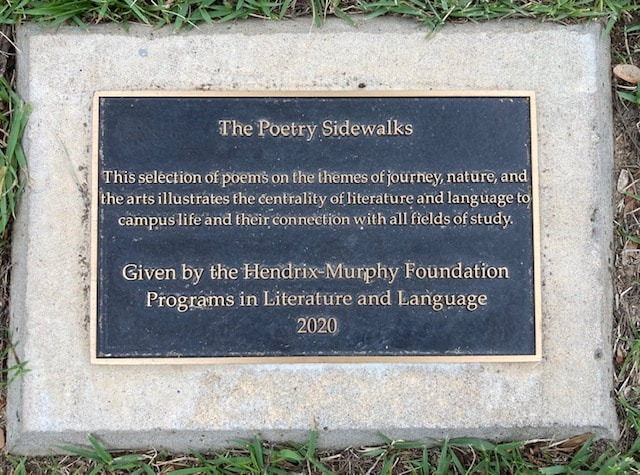 I found The Gardener, 85 by Rabindranath Tagore beside a bike rack and mouthed the words aloud. Who are you, reader, reading my poems an hundred years hence? I cannot send you one single flower from the wealth of the spring, one single streak of gold from yonder clouds. Open your doors and look around. From your blossoming garden gather fragrant memories of the vanished flowers of an hundred years before. In the joy of your heart may you feel the living joy that sang one spring morning, sending its glad voice across an hundred years. Then I placed an azalea blossom among the words, as a remembrance for the next reader. May you come across a poem that speaks to you – in your walks, reading, music – or create one from your own heart.
"Open your doors and look around." This idyllic cottage in Donegal (Glenties), Ireland burned on March 19. It has been the home to Breezy Kelly, a friend I've never met in person. We became friends via Facebook, connecting through our common belief in the power of bread to spread peace. I posted a story about her on my blog in October. The day after the fire, Breezy's cousin, Mary Lane, wrote to tell me about it. Thankfully, Breezy and her cat Tiddles were unhurt; but The Cottage, as Breezy calls it, was destroyed. The before and after images of Breezy's kitchen, where she Baked Bread for Peace, are heartbreaking. (photos by Mary). 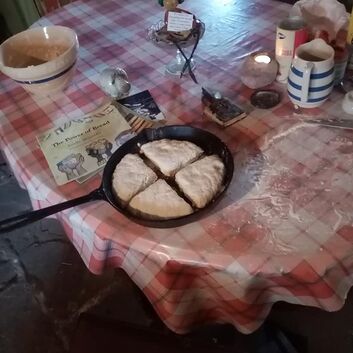 Breezy often posted pictures of her kitchen table, its red and white cloth dusted with flour, dough ready for the oven, a few books, quotes, and a tea pot. And my book, The Power of Bread, was often in sight. She kindly shared it with others who dropped by for a visit and "cuppa." Mary asked if I could possibly send another book since Breezy's only copy had been lost in the fire. I was touched that Breezy had even given a second thought to the loss of the book, and by Mary's thoughtfulness in contacting me. Of course, I was delighted to send extra copies and posted a package to Ireland. Then a few days later, I received an astonishing Facebook message from Breezy... 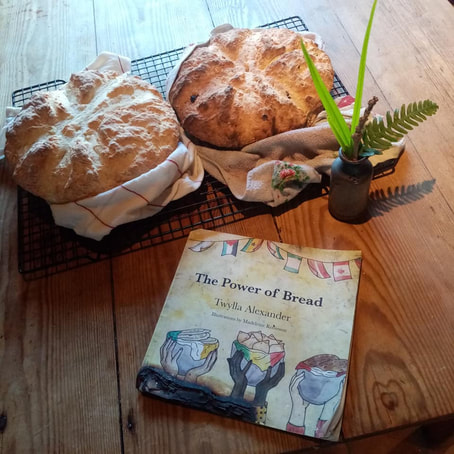 The book had been found among the ashes! Who knows how it survived when so many of Breezy's possessions did not. Breezy wrote.... "Its survival confirms the power of bread." To which I added, "the power of peace." The fresh loaves of bread in the photo confirm that Breezy is baking once again – at the home of friends, where she is staying until the cottage can be rebuilt. Breezy writes that she leaves the window open as she bakes... "so the Aroma of Peace wafts past me and out the door to bring peace to the four directions. And I remember to count my blessings." I'm grateful for Breezy's peaceful and generous spirit. And following in that spirit, I'm off to bake bread and pass it on. *For more information about Breezy's initiative, Bake Bread for Peace, check out the Facebook page. The images and headlines, the constant breaking news about the war in Ukraine, become more tragic every day. Even the words, "War in Ukraine" remain unbelievable to me. Yet the faces of hundreds of thousands of Ukrainian refugees crammed into trains – waiting hours to cross borders to safety – of children crying and parents carrying bags of hastily-gathered belongings, is heartbreakingly real. Drew and I feel particularly close to the situation because we lived in Russia for seven years, when he was Head of School at the Anglo-American School of Moscow, and I was a teacher. We became close friends with Russians who worked at the school. Sergei taught me how to drive in chaotic Moscow traffic; Zhenya and Matvey hosted us at their datcha; Natasha shared beautiful plants from her garden. We think of them now, knowing that the sanctions are impacting their lives, at no fault of their own. As Putin carries out his unprovoked and unspeakably inhumane invasion, people on both sides needlessly suffer. We search for ways to help, where/what to donate, how to make a difference. The outpouring of worldwide support to Ukraine is heartening, and we join those tangible efforts. But, on a daily basis, I ask myself, "What can I do?" "How can I be a part of the peace, not the anger?" One more angry person is the last thing the world needs right now. So I do the one thing that I always do when peace is illusive in my personal life or outside my window. I walk a labyrinth – a meditative walking path – where I slow my pace, my breathing, and simply put one foot in front of the other. I've walked the nearby labyrinth at Hendrix College several times since the Russian invasion, and each time find a bit more peaceful energy renewed. I stand in the center and send that energy to both Ukranians and Russians. This week I received an email from Ellen Bintz Meuch, a fellow Labyrinth Facilitator and founder of The Global Healing Response. Her email contained a meditation that can be used when walking a labyrinth, with specific intention to send peaceful energy around the Ukrainian/Russian situation. I've copied it below and highly recommend it as a tool for personal and global peace in the days ahead.
To find a labyrinth in your area, search the Worldwide Labyrinth Locator. To download a printable paper labyrinth to trace with your finger, click here. In the absence of either, the meditation can be used in the quiet of your own home as you direct peaceful energy to yourself and others. Peace be with us all. Global Healing Response for Ukraine/Russia Invasion by Ellen Bintz Meuch Intention My intention for this labyrinth walk is to feel the coherent energy of my own heart, then send that coherent energy to world leaders and those in the conflict in Russia and the Ukraine. Meditation (something you can read to yourself, prior to saying and walking with your intention). I fully release and let go of those things I cannot change. I let go of my fear of my own challenging world and that of the outside world. I breathe into my heart; I exhale from my heart. Let me begin my labyrinth walk with untying my own knots of chaos. I breath into my heart; I exhale from my heart. I begin to feel the heart center opening. Turmoil and conflict undo the world beyond my world. When I take a breath into my heart center, I steady my own energy, my own world. When I breath into my heart I feed my spirit with the sustainer of life, the breath. When I exhale from the heart, I am able to direct the gift of heart energy to anyone, anywhere. I know this to be true. I am grateful for this practice as I know I am full of generous potential, and capable of sharing it with others. I open my heart wide proclaiming myself as a resource for humanity. I begin walking my labyrinth, centered, unburdened, and connected to all. We connect as One, when we share our heart’s coherent energy. Would you start a 550-piece jigsaw puzzle if you knew it was missing one piece? Before you even opened the box, would you think, "What's the use?" or rather "Why not?" Maybe it makes a difference if you plan to keep it, like I did with a collection of Artsy Cats (by Mudpuddy), which I hung in the "grandkids" room. I just couldn't part with these cute kitties and their laughable names -- Clawed Monet, Vincat Van Gogh, Frida Catlo -- you get the picture. But I knew that the puzzle I selected to work during the holidays would not be a keeper. The winter scene fit the mood of festive lights and hot chocolate, and I would enjoy watching the community come together for an evening of shared fun. Then I would say goodbye to the idyllic scene and pass it on. 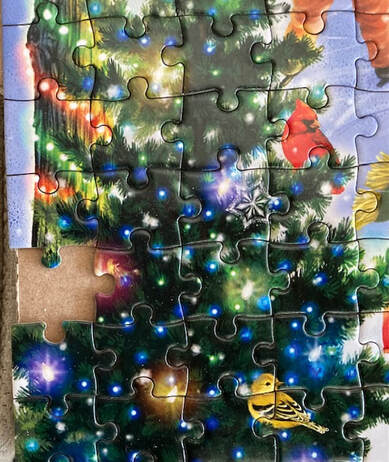 As the remaining pieces dwindled to about ten, I became increasingly aware that none – none! – of them would fit in the lone space on the left edge. Surely, that piece had not been missing from the beginning. It had obviously fallen off the dining room table and was blending in with the rug below. A hands and knees search would uncover it. No luck. Under a nearby cabinet, couch, chair? Nope. I lifted the cardboard workspace three times, thinking what? That the piece would magically appear where it had not appeared before? There was only one place left to look, the vacuum cleaner bag. Was I that intent on completing this puzzle that I would finger through mounds of dusty debris for one stray piece? Apparently so. Five gritty minutes later, I was still one piece short. After a calming cup of chai tea and self talk, I finally accepted that which I could not control. The puzzle would remain incomplete. But there's a much bigger picture here, of course, pun intended. The empty space did not cancel out my hours of pleasure in finding spots for the other 549 pieces. I could go on and on with fitting metaphors, but I have other puzzles to work. Hopefully, all 500 pieces are present and/or I won't misplace a piece along the way. But I'll start them anyway. Why not?
It looks like a fake photo, a stray leaf photoshopped onto an autumn scene. But it's not. First of all, I personally took the picture and secondly, I have no clue how to photoshop. A leaf really was suspended in midair, twirling, spinning, dancing, for at least 2 minutes! While nearby leaves were floating nonchalantly to the ground, this one was magically doing its own thing. But how? I circled it from every angle, clicking pictures with my phone, waiting for it to fall at any minute. Instead, it began turning somersaults, end over end, in some kind of joyful celebration. Then in an instant, the sun caught a thread – the color of a cloud – glistening ever so slightly. A spider's tricky handiwork. 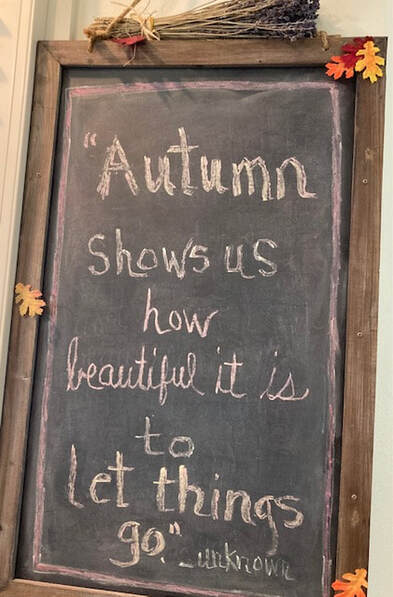 The leaf's message wasn't lost on me. In fact, I had been reading it on my kitchen chalk board every day for the last two weeks. I found the quote among an assortment of autumn sayings. Its truth and simplicity have become my mantra over a cup of coffee each morning as I've watched leaves detach from branches they've clung to for months. "Letting go can be a good thing," the leaves remind me. Beautiful, in fact. "Necessary," I add, knowing that new growth will never come as long as I'm clinging to worn out routines and unhealthy habits. What is it I need to let go of now? I never need to think long for a list to materialize. It's the actual letting go that's the challenge. I remember the leaf dancing in its new-found freedom, in the joy of what comes next. I smile at the possibilities. "Your lovely book is on its way to Ireland! I'll let you know when I hear from Breezy. She doesn't know who I am; I've only seen her here on Facebook. I just decided to send your book to her because she's always making gifts of her breads to others." (Facebook message March 31, 2021 from Kathy Fanning, a friend in Juneau, Alaska) Ireland? Breezy? Breezy who? I wrote Kathy back to thank her for her thoughtfulness and to ask for more details. She had little more to offer than a last name, Breezy Kelly, and a link to a Facebook Group – Bake Bread for Peace, which I immediately checked out. (Facebook message April 24 from Kathy) "Hi Twylla! Thought I'd share this sweet photo with you...I saw it on Breezy's page, and of course, was delighted to know the book found its way to her." There was my book, The Power of Bread, on a woman's table in Ireland, surrounded by three loaves of bread! They looked delicious and perhaps even still warm, having just been whisked out of the oven by the breadmaker's hands. I was stunned by the unlikeliness of it all – connections from Alaska to Ireland to me – and yet not. Acts of kindness and intention are rarely as serendipitous as they may seem. I sent Breezy a friend request, which she accepted, and we exchanged several FB messages. I was eager to learn more about her passion for baking bread and sharing her loaves with others. Fortunately, I found an article in the Belfast Telegraph, written by Ivan Little in July, 2018 – with a picture of Breezy and a loaf of bread. 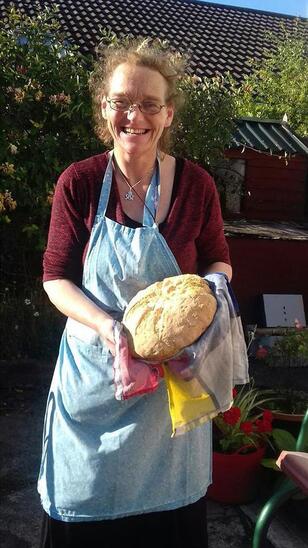 "Peace begins at home and in the community," Breezy said. We can do something on our own doorsteps to repair the awful disconnection." ...baking bread can make a difference." She went on to explain that the bread–peace connection came to her one night after watching the "grim" news on TV. "I felt afraid and as I went into the kitchen for tea. It suddenly struck me that baking bread and breaking bread are things that people do all over the world." Since then, Breezy has baked and shared bread with neighbors and in homes throughout Northern Ireland. Storytelling and singing are often part of the gatherings, or pehaps it's the aroma of a single loaf drifting out of her cottage window that spreads her message of peace. Breezy invites us all to pass on peace with a simple loaf of bread. I plan to join her and others around the world on October 24, for the 9th Annual International Bake Bread for Peace Day. Please consider baking a loaf yourself and sharing it. Not a bread baker? My favorite loaf of pumpkin bread comes from a box. Whatever you choose to bake, don't forget to stir in the most essential, yet invisible, ingredient – your own peaceful spirit.
|
Welcome to my blog!
After writing my books, Labyrinth Journeys ~ 50 States, 51 Stories and The Power of Bread, I knew I wasn't finished writing, or journeying. Please join me as I continue both and see where they lead me (and you!) ~Twylla Alexander |
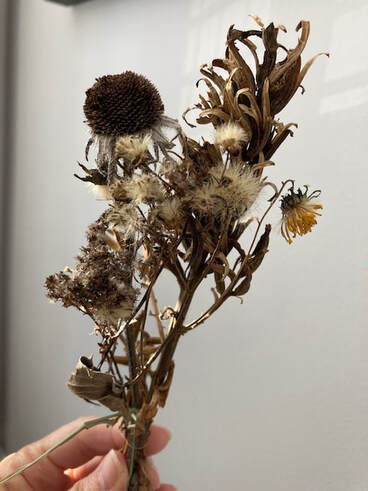
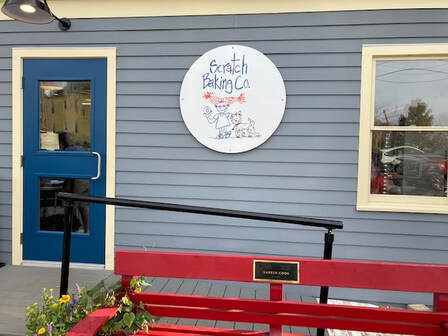
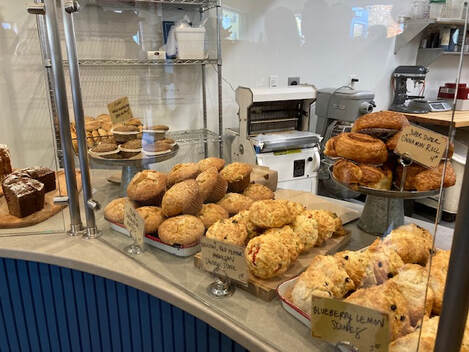
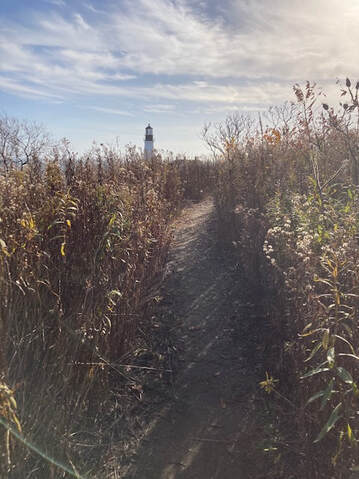
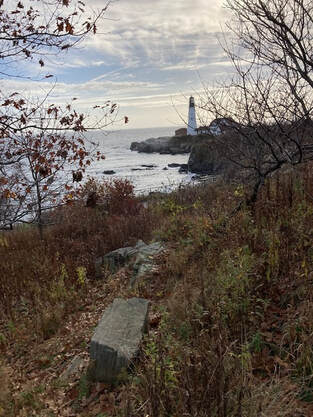
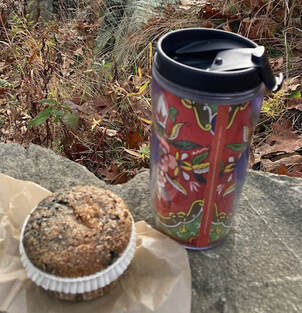
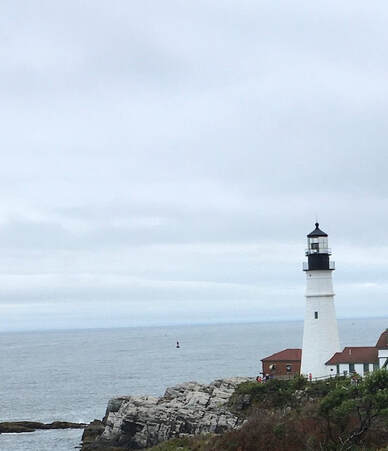
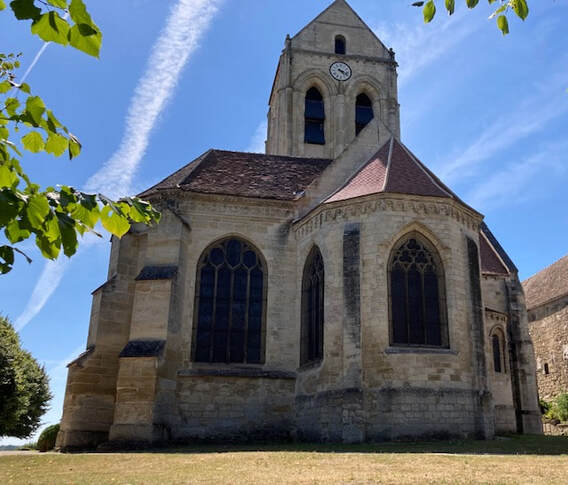
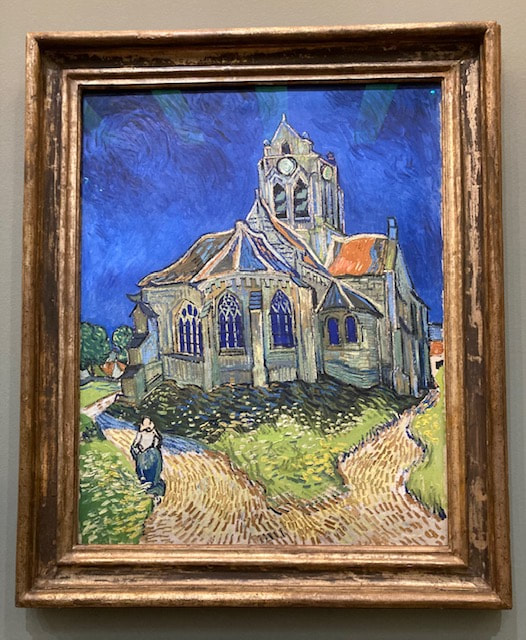
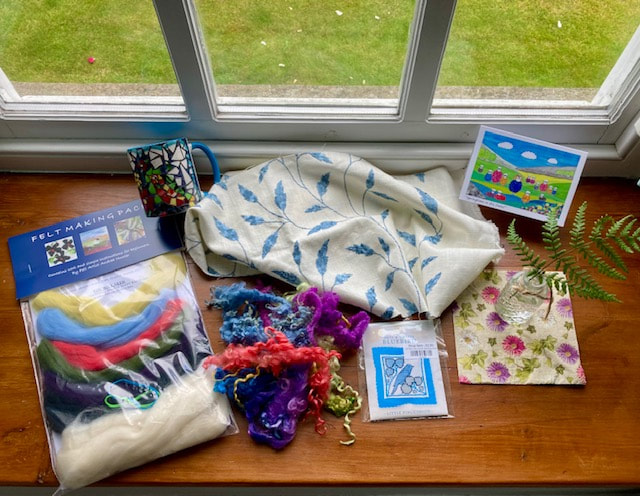
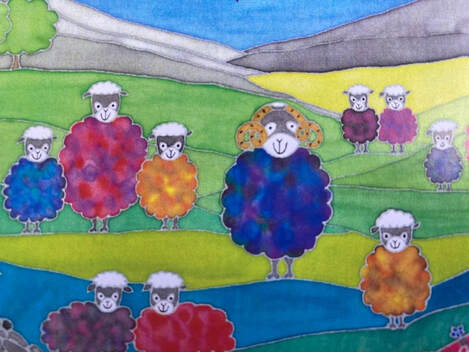
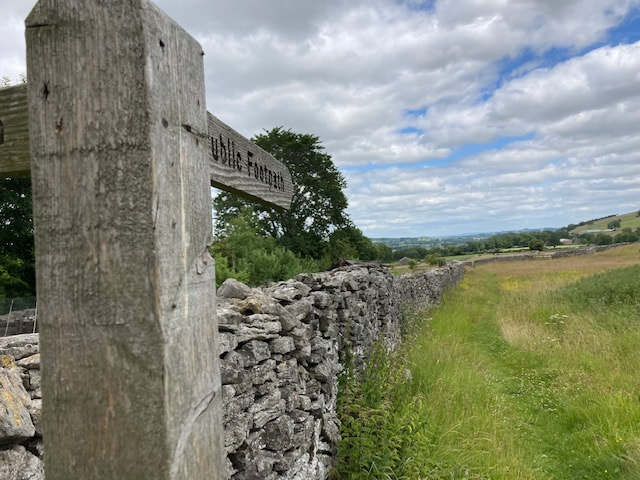
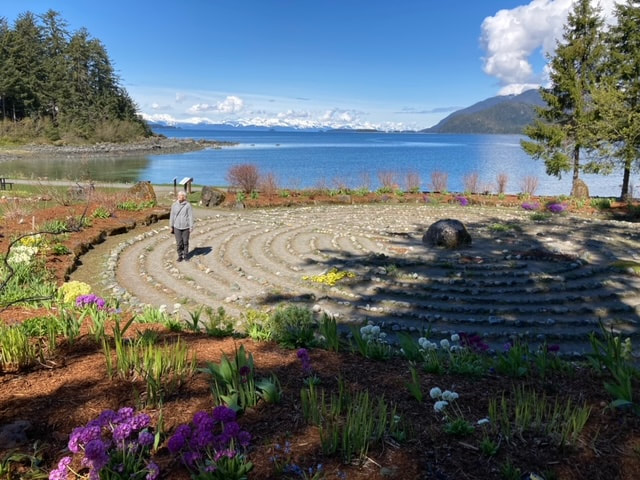
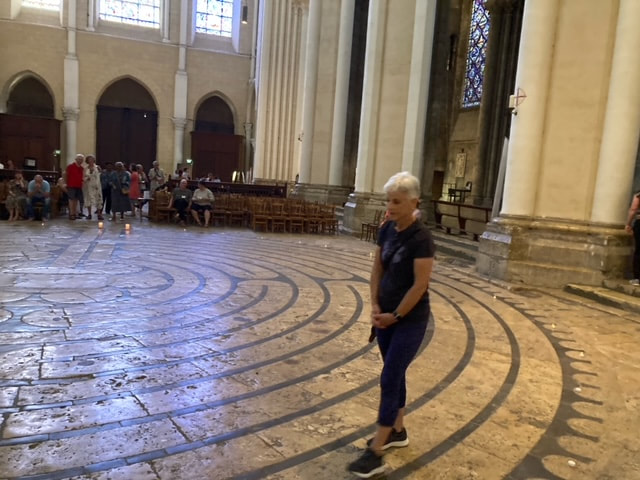
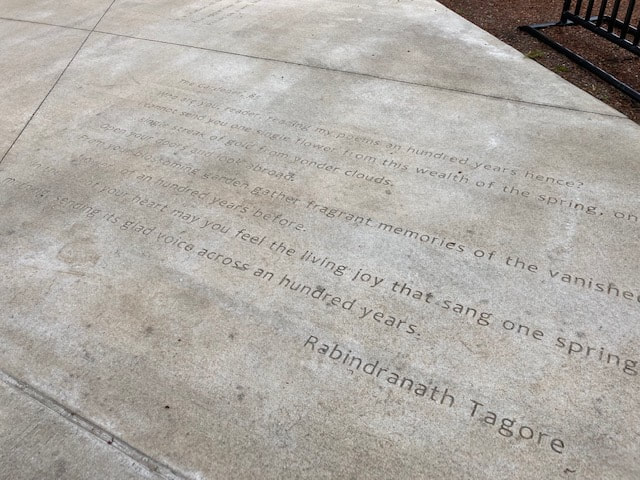
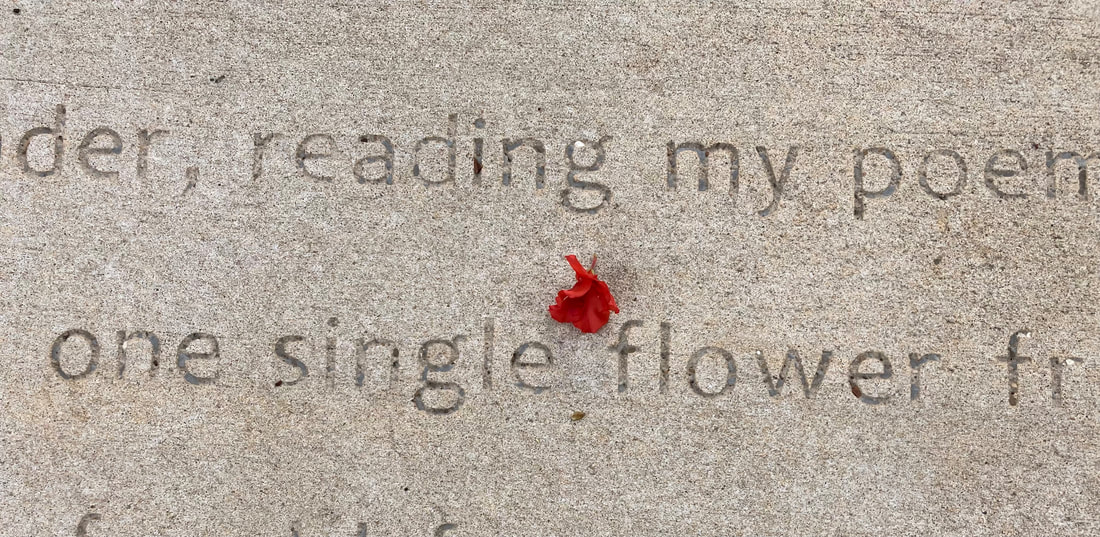
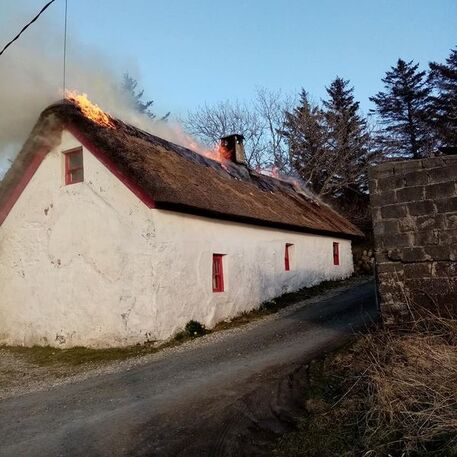
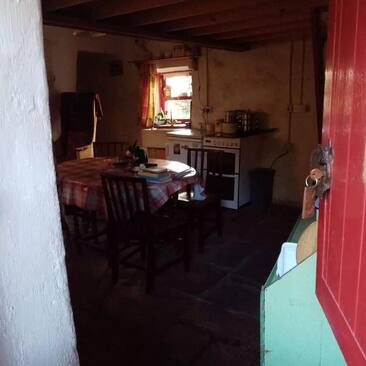

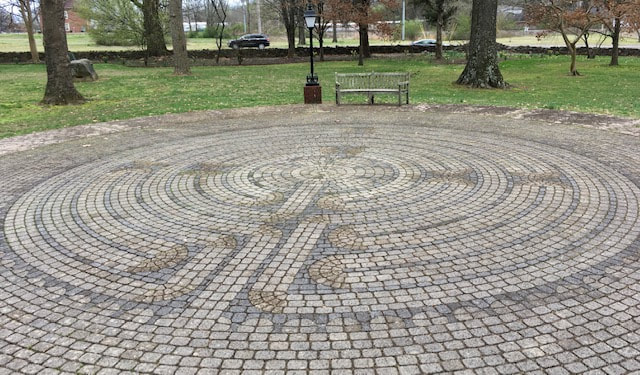

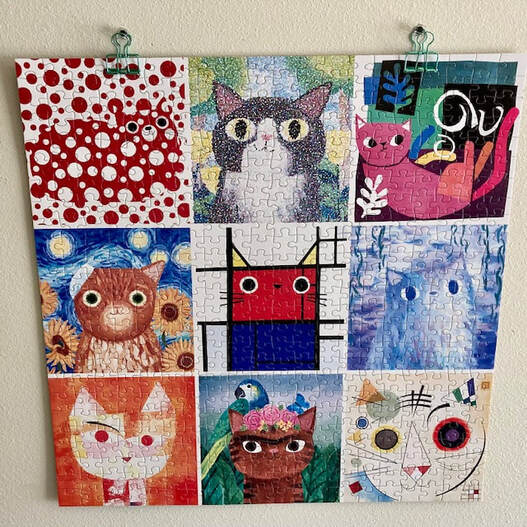

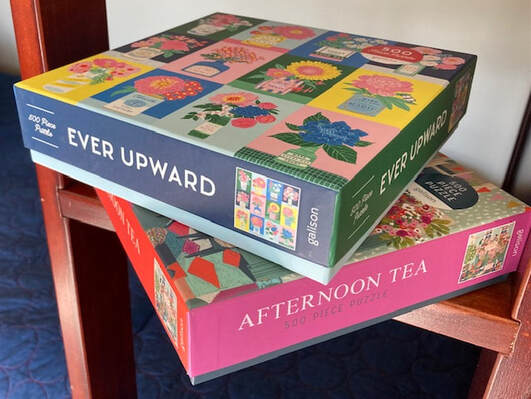
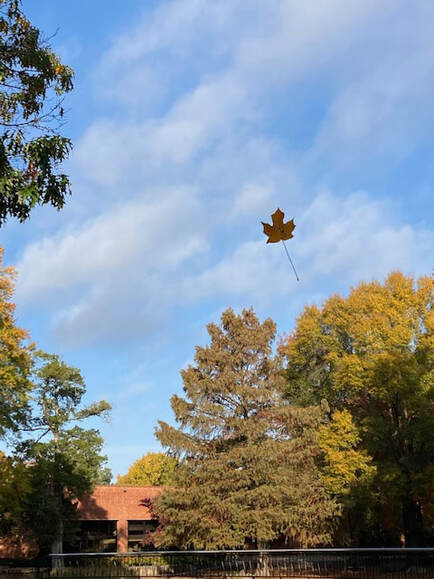
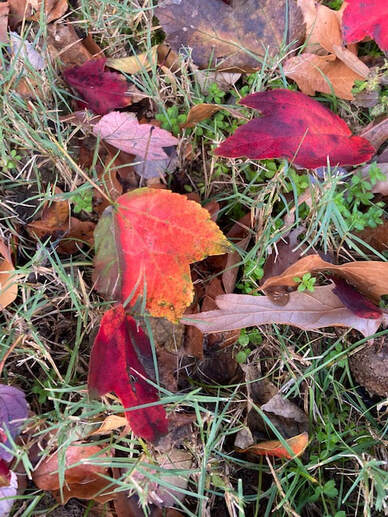
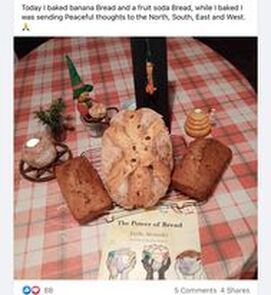

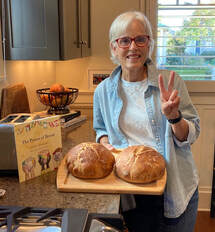
 RSS Feed
RSS Feed